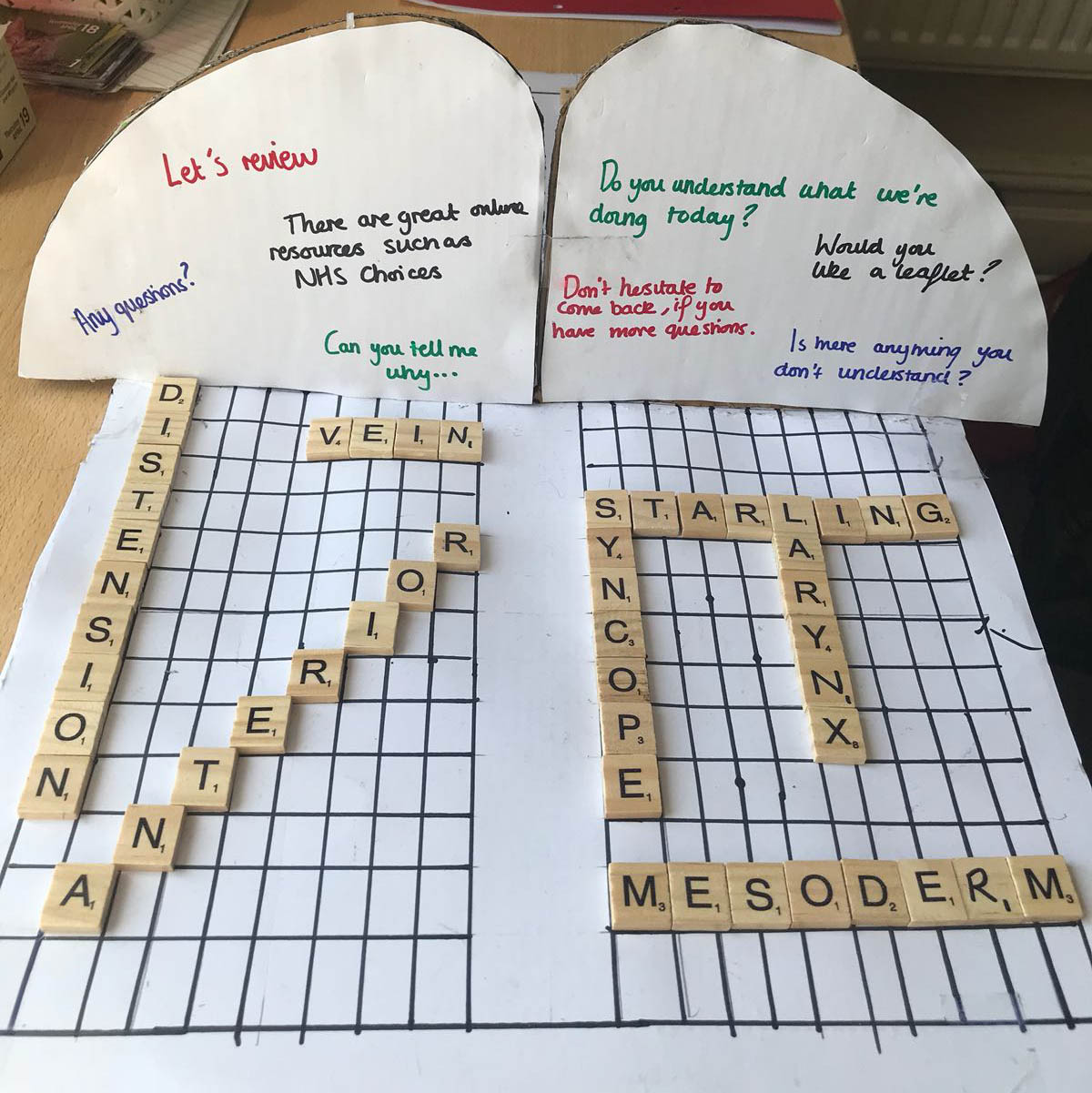The barrier of medical jargon.
However, one further significant point of conversation was his relationship with his doctors. Although he was complimentary about many of them, he remarked that he always felt there was a barrier between himself and the doctors. He specifically mentioned how medical jargon created an ‘us and them’ divide that he felt was difficult to bridge, and consequently this left him feeling intimidated and unable to ask questions.
My piece of art aims to show how different patients and doctors can be, but also how this inequality can be erased. The two sides of the board represent the words that a doctor would commonly use and ‘layman’ language. It’s clear that they’re very different however, the structure in the middle of the board represents a door. Either the patient can open this or the doctor – the writing on the door shows the key phrases that could lead to this line of communication being opened. The 3D representation meant that this abstract idea of ‘communication’ was much more tangible and physical. Seeing the words laid out physically in front of you, really forces a reflection on the divide between doctors and patients.
As medical students, it’s very easy to get excited and carried away with the new language you’re learning. All the new terms based in Latin gives a person a sense of importance and pride; however, it is important to remember that this language needs to be adapted to benefit your patients.

This creative piece really caught my eye as it encompassed the moot point of our Effective Consulting Labs and GP Placements for these past five weeks. The stark barrier between the complicated Latin and more common, understandable language is the perfect graphic representation of the concert boundary that can easily appear between the doctors in the scientific context and their patients without the same medical education.Having home-visited a patient last week too, I am constantly struck by how important the doctor-patient relationship is, and how reliant reporting, treatment, recover, and resilience is on this partnership. Patients who feel able to understand their doctor are more likely to comfortably share their symptoms, participate in discussion, and adhere to and understand the decided upon treatment plan. Often as students or scientists, we become very focused on the vocabulary and terminology — especially as there is so much of it to learn at medical school. However, it is so important to remain aware of the “laymen” perception; scary diagnoses are difficult enough without being mystified by tricky jargon too.
I was struck by the contrast in language in this piece, displayed so simply and yet such a vast difference. I think this really displays how easy it can be for medical professionals to use words that are so unfamiliar to patients, leaving them feeling isolated and confused. A key part of the piece is the suggestions to bridge this gap between the professional and patient, which leads to strengthening the doctor patient relationship, integral to the medical profession and yet something that can still go wrong. This has been a key component in our Foundations of Medicine programme and will continue to be throughout our profession. Communication is vital in every aspect of medicine, to comfort someone at the most vulnerable point of their lives, allowing them to feel listened to, understood and comforted, as well as between other members of the healthcare team. I think the piece really encompasses the importance of breaking down the barriers of communication in healthcare.
I really like how this piece visualises the struggles patients have when communicating with doctors. Using jargon builds a barrier in the doctor-patient relationship and can easily lead to a paternalistic approach to a consultation. Communication is a really important part of being an effective consulter and by using lay terms to speak to patients, it enables us to remove some of the barriers that it can create. This piece serves as a reminder not to get too caught up in medical thoughts and to remember who the consultation is about to ensure they get the best experience out of it.
This piece really expresses the way doctors will ensure that their patients are well informed of any conditions or diseases they may have. The work reinforces the importance of a doctor-patient relationship to ensure that the care directed is patient centred – ‘is there anything you don’t understand.’ This specific quote is an example of how doctors can make sure that patients are aware of any problems they may have and allows patients to have a better understanding to make an informed decision on the treatment plan. Being exposed to communication in GP placements, the importance of effective communication (without the use of medical jargon) was highlighted to me so doctors don’t overwhelm patients which in the future will establish and build the doctor-patient rapport, leading to more effective healthcare.
This simple yet striking piece resonates with me especially as a first year student. I think it is so common for us to get overwhelmed and excited with new complex terminology, yet we often forget how we need to communicate in clinical environments. In effective consulting and GP placements, we learn about forming rapports with patients, and using new scientific jargon will only complicate it and in doing so patient care can be jeopardised. Hence I think this piece illustrates this barrier clearly in a distinctive manner, that really visualises the divide between medical jargon and understandable terminology for patients (ensuring they are still fully informed about their treatment). It reminds medical students of how alert you are required to be in clinical environments when adapting your form of communication between the public and colleagues.